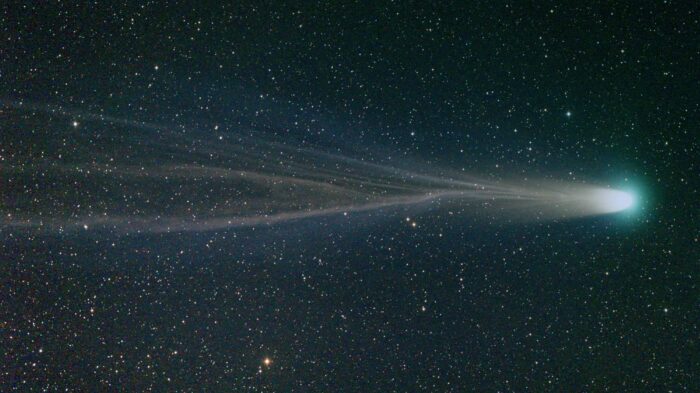Comet Leonard is one of the closest comets of our decade. It will be best to look at it in December. Sadly, it won’t last forever, so grab a telescope or binoculars. C/2021 A1 (Leonard) is a fascinating piece of our solar system. It has an orbit that revolves backward, has a cool looking tail and is very slow moving. All of this is part of Comet Leonard, a very beautiful and interesting object. Find the Comet Leonard tracker below.
It’s speed is a sizzling --,---
Where is Comet Leonard now? (live tracker)
3D Web App
Comet Leonard is currently --,--- from us, getting --,--- --,--- us every second, at --,---.
Why is it exciting
This comet is a really interesting one. Discovered on January 3, 2021, this comet came close enough to our planet for us to observe it closely. This way, we can see all of the little details, such as the comet itself and its beautiful tail. If it were further, such as its furthest point from us, we wouldn’t be able to make out much. This event is very rare for this specific comet. It got very close, and it was 21 million miles away.
The great part, is in the southern hemisphere, it will be relatively bright. In December of 2021, it should have a high magnitude, or brightness in this case. However, you will still need a telescope to see it. This is a once in a lifetime chance to see this comet, so be prepared with a telescope by your side.
Since last night Comet Leonard got --,--- further. Since you started looking at this page it is --,--- further .
What causes the spectacular tail?
When a comet comes close to the sun, radiation is blasted at the comet from the sun. The comet will lose a little bit of trapped gas and dust, and it will come off as a beautiful tail of small particles. Usually, this tail is great in size. It depends on how close it is to its parent star. The closer it is, the larger the tail is as there is more radiation hitting the comet. With Leonard, you can see the dust sort of radiating off of the comet. This shows how the comet tail works. At the top of the comet is the Nucleus, which is where all of the dust and radiation is coming from. This one has a nucleus of about 1 Kilometer, or 0.6 Miles.
Will it return?
The bad news is no, it will not return. It is located on an orbit that takes it around the sun and because of the sun’s gravity, kicks it out of our solar system. It has been in orbit for 40,000 years. The comet will basically come close to Earth, Venus, and the Sun, and get out. It will take another 40,000 years for it to leave. Some other comets, like Halley’s comet, return, and quickly too. In Halley’s case, about every 75 years.
Once again, this comet will never visit us again. It is destined, after another 40,000 years, to drift through the galaxy until it finds a new star to call home. So, grab a bag of popcorn, sit down outside, and watch it as it slowly drifts away.
Comet Leonard has the official name C/2021 A1 (Leonard).
Sources and References:
https://en.wikipedia.org/wiki/C/2021_A1_(Leonard)
https://en.wikipedia.org/wiki/Comet_tail
https://www.space.com/comet-leonard-closest-to-earth
*This Interactive 3D Simulation is built on data provided by NASA JPL HORIZONS database for solar system objects and International Astronomical Union’s Minor Planet Center. Distances and speeds are estimates based on this data.
Photo Credit and other: NASA, ESO/S. Brunier, NASA/JHUAPL/SwRI, NASA/JPL-Caltech, JAXA, University of Tokyo & collaborators, UH/IA, Solar System Scope/INOVE CC BY 4.0, Wikipedia/Creative Commons Attribution-ShareAlike License, icons8.com, Péter Eke, NASA/Goddard/University of Arizona/Roman Tkachenko, Wikimedia Commons, Hayabusa 2 Arrival illustration by Akihiro Ikeshita (permission granted), oNline Web Fonts, Font Awesome, Galaxy vector created by stories – www.freepik.com

